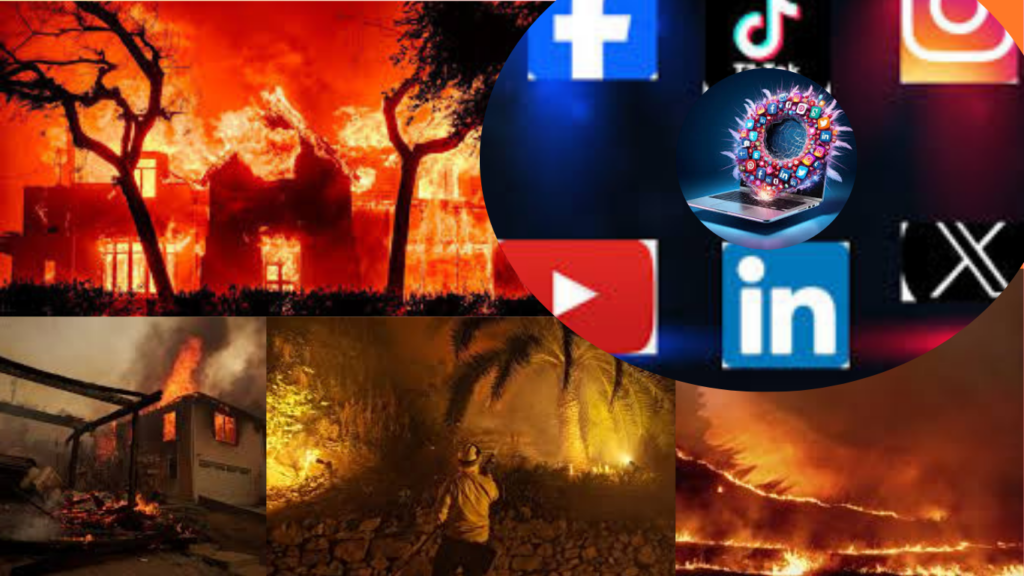Table of Contents
Toggle
Social Media Erupts as Fire Engulfs Los Angeles: A Comprehensive Report
The world woke up to shocking headlines as a massive fire broke out in Los Angeles, spreading rapidly and dominating conversations across social media platforms. This report delves into how platforms like Facebook, YouTube, Twitter, Instagram, TikTok, and blogs around the globe rallied to share updates, spread awareness, and showcase the power of digital media in real-time crises.
The Incident: Los Angeles on Fire
In the early hours of the day, a devastating fire erupted in Los Angeles, sending plumes of smoke into the sky and sparking emergency evacuations. The fire, believed to have started due to an electrical fault, quickly spread through residential and commercial areas. The rapid spread was attributed to dry conditions and strong winds. By mid-morning, the situation had escalated to a city-wide emergency, drawing attention from not only local authorities but also global media.
The Role of Social Media in Crisis Reporting
Social media platforms played a crucial role in bringing the incident to the forefront of global attention. From live updates to emotional posts, the fire’s impact was felt across every corner of the internet.
Facebook: The First Wave
Facebook users were among the first to report the fire. Witnesses posted videos and images, tagging locations to provide real-time updates. Community groups and local government pages issued safety advisories, shared evacuation routes, and offered shelters for displaced residents. Facebook’s live streaming feature became a vital tool for citizen journalists on the ground.
Twitter: The Fastest News Source
Twitter, often known for its immediacy, was flooded with hashtags like #LAFire, #LosAngelesFire, and #PrayForLA. Verified accounts from fire departments, emergency services, and news outlets provided moment-to-moment updates. Users retweeted crucial information, ensuring that news spread far and wide.
Instagram: Visual Storytelling
Instagram brought a more visual perspective to the disaster. Stunning yet harrowing photos of the fire’s aftermath and stories of bravery from first responders gained massive traction. Influencers and local residents used Stories and Reels to share their experiences, creating a sense of global solidarity.
YouTube: In-Depth Coverage
YouTube served as a platform for long-form coverage. News outlets and independent creators posted detailed videos, including drone footage of the fire’s spread and interviews with affected individuals. Tutorials on fire safety and emergency preparedness also gained popularity.
TikTok: Engaging the Youth
TikTok introduced a distinct wave of updates, enhancing its signature short-form content experience. Creative users combined information with engaging visuals, reaching younger audiences. Hashtags like #LAFireChallenge encouraged users to share fire safety tips in innovative ways.
Blogs: Analytical Perspectives
Prominent blogs like WorldStan.com provided in-depth analysis of the incident. Articles explored the root causes, government response, and the broader implications of urban fires in a changing climate. These blogs served as an essential resource for those seeking a deeper understanding.
Global Reactions
The fire’s impact was felt far beyond Los Angeles, as international communities rallied to support. Social media amplified voices from around the globe, with users sending thoughts, prayers, and donations to relief efforts.
Fundraising Campaigns
Platforms like GoFundMe and Facebook’s fundraising feature were used to collect donations for affected families. Influencers and celebrities, leveraging their massive followings, played a significant role in mobilizing financial aid.
Government and NGO Efforts
Governments and NGOs used social media to coordinate relief efforts. From organising food and medical supplies to updating citizens on rescue operations, digital platforms were indispensable in managing the crisis.
Lessons from the Los Angeles Fire
The incident underscores the importance of preparedness and the evolving role of social media in emergencies. Here are some key takeaways:
The Power of Real-Time Updates Social media allows for instant dissemination of critical information, helping save lives.
Community Solidarity Platforms foster a sense of unity, enabling people to come together in times of need.
Digital Literacy is Essential Users must be able to discern credible sources to avoid misinformation during crises.
The Future of Crisis Management in a Digital Age
The Los Angeles fire has set a precedent for how social media can be harnessed in emergencies. Moving forward, there is a need for:
Enhanced Collaboration: Governments, NGOs, and tech companies must work together to create more robust crisis response tools.
AI-Driven Alerts: Advanced technologies can help predict and mitigate disasters, ensuring timely action.
Public Awareness Campaigns: Regular education on using social media responsibly during emergencies is crucial.
Conclusion
The Los Angeles fire serves as a powerful reminder of nature’s unpredictability and the vital need for unity in times of challenge. Social media, with its unparalleled reach and immediacy, has proven to be a game-changer in crisis management. As platforms continue to evolve, their role in shaping global responses to disasters will undoubtedly grow.
WorldStan.com and its dedicated team of writers, researchers, and digital media experts remain committed to bringing timely, accurate, and impactful stories to readers worldwide. Together, we navigate a digital landscape where every post, tweet, and story has the power to make a difference.
